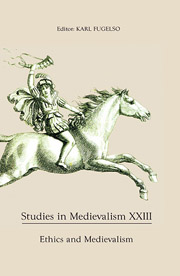Book contents
- Frontmatter
- Acknowledgments
- Contents
- List of Illustrations
- Epigraph
- Editorial Note
- I Ethics and Medievalism: Some Perspective(s)
- II Interpretations
- What if the Giants Returned to Albion for Vengeance? Crusade and the Mythic Other in the Knights of the Nine Expansion to The Elder Scrolls IV: Oblivion
- The Dark Ages of the Mind: Eugenics, Amnesia, and Historiography in Dan Brown's Inferno
- Plastic Pagans: Viking Human Sacrifice in Film and Television
- Meat Puzzles: Beowulf and Horror Film
- Words, Swords, and Truth: Competing Visions of Heroism in Beowulf on Screen
- Socialism and Translation: The Folks of William Morris's Beowulf
- “We Wol Sleen this False Traytor Deeth”: The Search for Immortality in Chaucer's Pardoner's Tale and J. K. Rowling's The Deathly Hallows
- Intention or Accident? Charles Alfred Stothard's Monumental Effigies of Great Britain
- Contributors
- Previously published volumes
Meat Puzzles: Beowulf and Horror Film
from II - Interpretations
Published online by Cambridge University Press: 05 May 2014
- Frontmatter
- Acknowledgments
- Contents
- List of Illustrations
- Epigraph
- Editorial Note
- I Ethics and Medievalism: Some Perspective(s)
- II Interpretations
- What if the Giants Returned to Albion for Vengeance? Crusade and the Mythic Other in the Knights of the Nine Expansion to The Elder Scrolls IV: Oblivion
- The Dark Ages of the Mind: Eugenics, Amnesia, and Historiography in Dan Brown's Inferno
- Plastic Pagans: Viking Human Sacrifice in Film and Television
- Meat Puzzles: Beowulf and Horror Film
- Words, Swords, and Truth: Competing Visions of Heroism in Beowulf on Screen
- Socialism and Translation: The Folks of William Morris's Beowulf
- “We Wol Sleen this False Traytor Deeth”: The Search for Immortality in Chaucer's Pardoner's Tale and J. K. Rowling's The Deathly Hallows
- Intention or Accident? Charles Alfred Stothard's Monumental Effigies of Great Britain
- Contributors
- Previously published volumes
Summary
What would an ocean be without a monster lurking in the dark?
It would be like sleep without dreams.
(Werner Herzog)Brought face to face at last with her monstrous antagonist, the redoubtable Ripley of Alien 3 (1992) shivers in disgust as viscous drool oozes from the xenomorph's lipless mouth. In a comparatively restrained image from The Silence of the Lambs (1991), Hannibal the Cannibal Lector noisily sucks saliva through his teeth, describing with relish how he once ate a census taker's liver, “with fava beans and a nice chianti.” These images seethe with the horror film's voracious appetite for terror and revulsion, its slavering abjectness. No surprise at all, then, to find Wealhtheow falling victim to goo dripping from Grendel's lopsided maw in the 2007 Beowulf. In Outlander (2008), the warrior-princess Freya suffers a similar breach of bodily containment when the creature's saliva slops down onto her face as she lies upon a hill of human meat. An unacknowledged Beowulf analogue from the 1970s bears the delicate title Raw Meat (1973), wherein the lone descendant of a band of cannibals lives with his pregnant paramour in a tunnel beneath the London tube. The night stalker raids the tubes above to feed his family, desperate to carry on his line. His single weak spot is a livid, swollen ear, which a potential victim strikes in order to incapacitate him, releasing a stream of gore — an idea deliberately echoed in the hero's fight with Grendel in Robert Zemeckis’ Beowulf (2007).
- Type
- Chapter
- Information
- Studies in Medievalism XXIIIEthics and Medievalism, pp. 123 - 146Publisher: Boydell & BrewerPrint publication year: 2014



